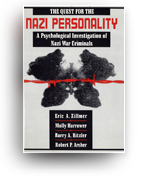 |

Open to Interpretation…The Art and Science of Inkblots
Ashland, OH: Hogrefe, 2009
[more]
............................................
Principles of Neuropsychology
Belmont, CA: Wadsworth, 2008
[more]
............................................
Military Psychology: Clinical and Operational Applications
New York, NY: Guilford, 2006
[more]
............................................
The Quest for
the Nazi Personality
Hillsdale, NJ: Lawrence Erlbaum Associates, 1995
............................................
Neuropsychological Assessment and Intervention
Springfield, IL: Charles Thomas, 1992
[more]
|
 |
|
 |
 |
 |
THE QUEST FOR THE NAZI PERSONALITY:
A Psychological Investigation of Nazi War Criminals

Eric A. Zillmer, Molly Harrower, Barry A. Ritzler, & Robert P. Archer
Hillsdale, NJ: Lawrence Erlbaum Associates, 1995
|

So you always show the same series of inkblots. Why are there only ten in the series?
That goes back to how Hermann Rorschach developed the test. Rorschach was a Swiss psychiatrist who worked at the famous Burghölzli Hospital, which was the Mayo Clinic of 80 years ago. That's where the brightest minds of Europe would congregate to understand how people with mental disorders think and behave. Carl Jung was at the hospital at the same time. What Rorschach did, which is really ingenious, was to look for an unstructured testing situation for his schizophrenic patients where he might learn something about them that he did not know beforehand. He knew of a game that German kids play where they sit on a hill and look at the clouds and make up things they see in the clouds. The game would be whether you as a friend could see the shape as well. There was also another game, which he played as a kid, called "Klexen" which was just putting ink on a paper, folding it, and seeing what you can see. Also significant is that Rorschach's father was a graphic artist. So he started experimenting with dozens of inkblots on mostly schizophrenics at his hospital and he found it was a technique that could be useful.
In 1921 he then wrote his classic book on the technique, Psychodiagnostik. It's a scholarly, professional book that outlines a very precise procedure that he was trying to develop for psychiatrists and psychologists. But he also wanted to have his first set of inkblots printed. He had to pay for this himself. At that time he didn't know how many he wanted to have printed and he submitted at dozens of his original inkblots to the printer, but the printer only printed ten of the plates because of the resources that Rorschach had. That's why we have ten. The truth is probably that you could use any ten complicated inkblots, and many people have tried to replicate their own set of inkblots, but the Rorschach blot are the most popular to this date.
Next Question...
|
|